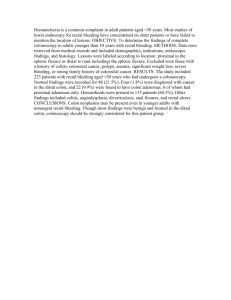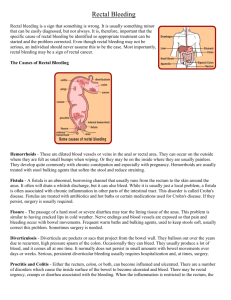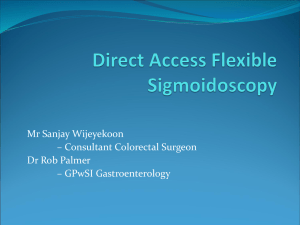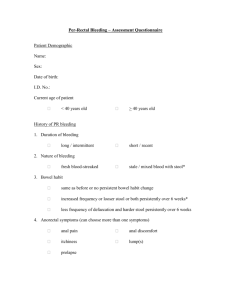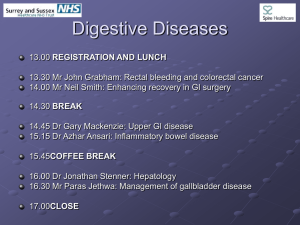A Study of Bleeding Per Rectum in Paediatric Age Group
advertisement
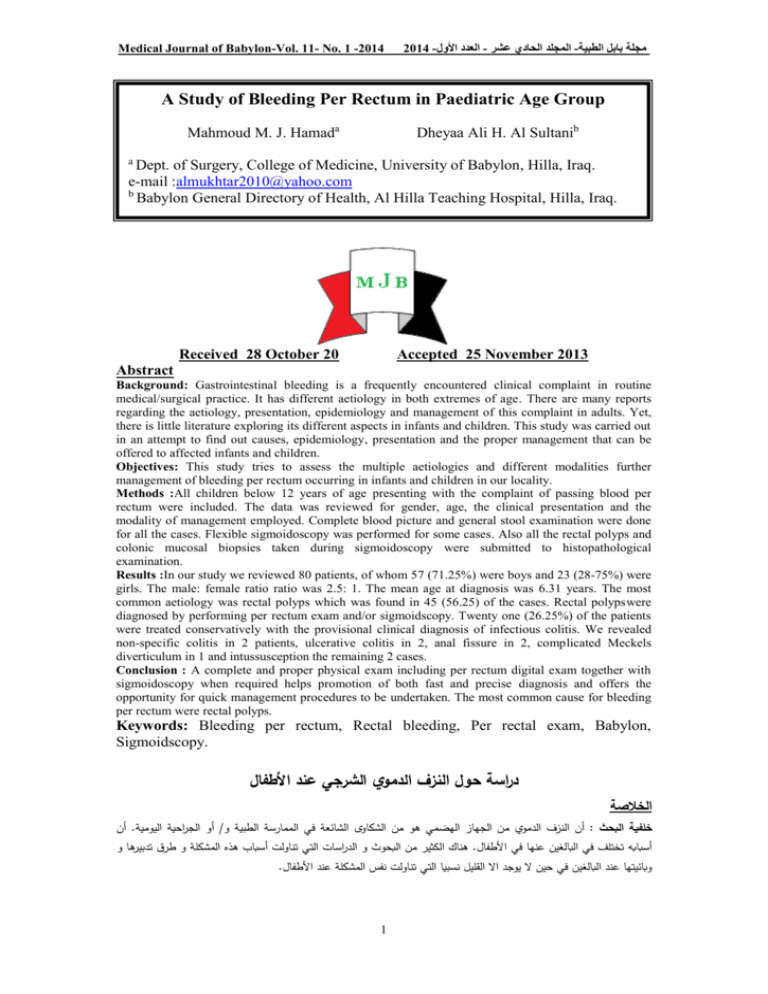
Medical Journal of Babylon-Vol. 11- No. 1 -2014 1024 - العدد األول- المجلد الحادي عشر-مجلة بابل الطبية A Study of Bleeding Per Rectum in Paediatric Age Group Mahmoud M. J. Hamada Dheyaa Ali H. Al Sultanib a Dept. of Surgery, College of Medicine, University of Babylon, Hilla, Iraq. e-mail :almukhtar2010@yahoo.com b Babylon General Directory of Health, Al Hilla Teaching Hospital, Hilla, Iraq. Received 28 October 20 Accepted 25 November 2013 Abstract Background: Gastrointestinal bleeding is a frequently encountered clinical complaint in routine medical/surgical practice. It has different aetiology in both extremes of age. There are many reports regarding the aetiology, presentation, epidemiology and management of this complaint in adults. Yet, there is little literature exploring its different aspects in infants and children. This study was carried out in an attempt to find out causes, epidemiology, presentation and the proper management that can be offered to affected infants and children. Objectives: This study tries to assess the multiple aetiologies and different modalities further management of bleeding per rectum occurring in infants and children in our locality. Methods :All children below 12 years of age presenting with the complaint of passing blood per rectum were included. The data was reviewed for gender, age, the clinical presentation and the modality of management employed. Complete blood picture and general stool examination were done for all the cases. Flexible sigmoidoscopy was performed for some cases. Also all the rectal polyps and colonic mucosal biopsies taken during sigmoidoscopy were submitted to histopathological examination. Results :In our study we reviewed 80 patients, of whom 57 (71.25%) were boys and 23 (28-75%) were girls. The male: female ratio ratio was 2.5: 1. The mean age at diagnosis was 6.31 years. The most common aetiology was rectal polyps which was found in 45 (56.25) of the cases. Rectal polypswere diagnosed by performing per rectum exam and/or sigmoidscopy. Twenty one (26.25%) of the patients were treated conservatively with the provisional clinical diagnosis of infectious colitis. We revealed non-specific colitis in 2 patients, ulcerative colitis in 2, anal fissure in 2, complicated Meckels diverticulum in 1 and intussusception the remaining 2 cases. Conclusion : A complete and proper physical exam including per rectum digital exam together with sigmoidoscopy when required helps promotion of both fast and precise diagnosis and offers the opportunity for quick management procedures to be undertaken. The most common cause for bleeding per rectum were rectal polyps. Keywords: Bleeding per rectum, Rectal bleeding, Per rectal exam, Babylon, Sigmoidscopy. دراسة حول النزف الدموي الشرجي عند األطفال الخالصة أن. أو الجراحية اليومية/ أن النزف الدموي من الجهاز الهضمي هو من الشكاوى الشائعة في الممارسة الطبية و: خلفية البحث هناك الكثير من البحوث و الدراسات التي تناولت أسباب هذه المشكلة و طرق تدبيرها و.أسبابه تختلف في البالغين عنها في األطفال .وبائيتها عند البالغين في حين ال يوجد اال القليل نسبيا التي تناولت نفس المشكلة عند األطفال 1 Medical Journal of Babylon-Vol. 11- No. 1 -2014 1024 - العدد األول- المجلد الحادي عشر-مجلة بابل الطبية تحاول هذه الدراسة أستكشاف اسباب النزف الدموي الشرجي عند األطفال مع تناول مختلف الطرق التشخيصية و العالجية: األهداف .المتوفرة تم أستعراض و.) سنة من العمر ممن يعانون من النزف الدموي الشرجي21( شملت الدراسة كل األطفال الذين هم دون سن: الطريقة لقد تم أجراء فحص صورة الدم الكاملة مع أجراء فحص البراز العاملكل الحاالت.دراسة الجنس و العمر و نوع التداخل العالجي المقدم لقد تم أجراء الفحص النسيجي لكل الزوائد المسقيمية.المدروسة كما تم أجراء فحص ناظور الجهاز الهضمي ال سفلي عند الحاجة لذلك .و الخزعات المأخؤة من بطانة القولون ) أنثى و كانت نسبة12( ) ذك ار و75( ) طفال ممن يعانون من النزف الدموي الشرجي وكان فيهم08( تم أستعراض و دراسة: النتائج وجدنا إن اكثر االسباب شيوعا" لهذه المشكلة8 ) سنة3.2( ) و أن متوسط المعدل العمري كان2 : 1.7( الذكور الى األناث هي ) من الحاالت باجراء الفحص الشرجي باالصبع بدون% 73,17( 57 عند االطفال هو وجود الزوائد المستقيمية والتي تم اكتشافها في ) تحفظيا" على إعتبار ان التشخيص االولي للمرض هو التهاب% 13, 17( حالة12 تم عالج8 او مع تنظير اسفل القولون/ حالتين من التهاب القولون التقرحي وحالتين من الفطر الشرجي, تم اكتشاف حالتين من التهاب القولون الالنوعي8 القولون االنتاني 8مع حالتين للتداخل المعوي وحالة واحدة لجريب مكلز او مع تنظير اسفل القولون/ ان اجراء الفحص السريري الكامل والشامل والمتضمن اجراء الفحص الشرجي باالصبع بدون: األستنتاج تبين ان8 عند الحاجه لذلك هوضمان للوصول الى التشخيص الصحيح مما يساعد في منح المريض افضل التدابير العالجية وبسرعة 8الزوائد المستقيمية هو اكثر االسباب شيوعا" لحدوث النزف الدموي الشرجي عند االطفال محافظة, تنظير اسفل القولون, الفحص الشرجي باالصبع, مفاتيح الكلمات النزف الدموي الشرجي عند االطفال .بابل ـ ـ ـ ـ ـ ـ ـ ـ ـ ـ ـ ـ ـ ـ ـ ـ ـ ـ ـ ـ ـ ـ ـ ـ ـ ـ ـ ـ ـ ـ ـ ـ ـ ـ ـ ـ ـ ـ ـ ـ ـ ـ ـ ـ ـ ـ ـ ـ ـ ـ ـ ـ ـ ـ ـ ـ ـ ـ ـ ـ ـ ـ ـ ـ ـ ـ ـ ـ ـ ـ ـ ـ ـ ـ ـ ـ ـ ـ ـ ـ ـ ـ ـ ـ ـ ـ ـ ـ ـ ـ ـ ـ ـ ـ ـ ـ ـ ـ ـ ـ ـ ـ ـ ـ ـ ـ ـ ـ ـ ـ ـ ـ ـ ـ ـ ـ ـ ـ ـ ـ ـ ـ ـ ـ ـ ـ ـ ـ ـ ـ ـ ـ ـ ـ ـ ـ ـ ـ ـ ـ ـ ـ ـ ـ ـ ـ ـ ـ ـ ـ ـ ـ ـ ـ ـ ـ ـ ـ ـ ـ ـ ـ ـ ـ ـ ـ ـ ـ ـ ـ ـ ـ ـ ـ ـ ـ ـ ـ ـ ـ ـ ـ ـ ـ ـ ـ ـ ـ ـ ـ ــ ـ ـ ـ ـ ـ ـ ـ ـ ـ ـ ـ ـ ـ ـ ـ ـ ـ ـ ـ ـ ـ ـ ـ ـ ـ ـ ـ ـ ـ ـ ـ ـ ـ ـ ـ ـ ـ ـ ـ ـ ـ ـ ـ ـ ـ ـ ـ ـ ـ ـ ـ ـ ـ ـ ـ ـ ـ ـ ـ ـ ـ ـ ـ ـ ـ ـ ـ ـ ـ ـ ـ ـ ـ ـ ـ ـ ـ ـ ـ ـ ـ ـ ـ ـ ـ ـ ـ ـ ـ ـ ـ ـ ـ ـ ـ ـ ـ ـ ـ ـ the management of these children. A carefully taken history, proper and complete exam of the perianal region, digital per rectum exam and general stool exam can find out the most common causes of this problem [4-6]. More advanced diagnostic techiques e.g. endoscopy, radiology, technetiumlabled red blood cells scans and angiography are used for the diagnosis of more difficult cases. Introduction leeding per rectum is a common clinical problem in our mediacl/surgical practice. Most of general practitioners do not have much appreciation regarding the aetiologies and management modalities of bleeding per rectum in paediatric age group. This may explain the mismanagement of this problem. Lower gastrointestinal bleeding in infants and children is commonly encountered in clinical practice, although its epidemiology has not been well evaluated [1-3].The aetiology of lowergastrointestinal bleeding in children is different from that in adults. The causes are usually simple and need little or no treatment e.g. anal fissure, juvenile polyps but sometimes it may present as more serious and threatening conditions e.g. intussusception, midgut volvulus, Meckels diverticulum and peptic ulcer disease [3-4].Chronic cases of minor lower gastrointestinal bleeding produces significant anemia. Accordingly, detection and localization of the aetiology is an important part in B Patients and Methodology In this study we reviewed 80 children from January 2012 to July 2013who were managed in our institutions of Al Hilla Teaching Hospital and Al-Noor Paediatric Hospitals for their complaint of bleeding per rectum. All children who were under 12 years with bleeding per rectum were included to document the clinical characteristics and the management that was performed. In case of rectal polyp, polypectomy was undertaken and polyps were submitted to histopathology. In cases where no polyps were detected using digital per 2 Medical Journal of Babylon-Vol. 11- No. 1 -2014 1024 - العدد األول- المجلد الحادي عشر-مجلة بابل الطبية rectum exam, empirical management provided with the provisional diagnosis of suspected infectious colitis secondary to Gram- negative bacteria and/or Entamoebahistolytica. The treatment regime offered consisted of Metronidazole combined with Nalidixic Acid for a period of 14 days. Results of general stool examination were recorded and assessed. In cases treated on empirical basis and still continue to have persistent bleeding per rectum, sigmoidoscopy was undertaken. All other causes of bleeding per rectum were managed accordingly. Data obtained regarding clinical presentation, demography of bleeding per rectum, sigmoidoscopy findings and histopathological results were studied and analyzed. rectal polyps were diagnosed in 44 (97.7%) cases while there was 2 polyps in one case. Uncomplicated surgical polypectomy was performed in all the cases successfully. Biopsies of all the 45 cases of rectal polyps revealed juvenile polyps. Of the 80 cases, 30(37.5%) cases showed no obvious aetiology for their bleeding and they were assumed to be cases of infectious colitis and managed initially conservatively for 14 days. Twenty two (70%) cases showed good response to treatment offered and complete relieve on subsequent follow up. In the remaining 8(26.66%) cases which continue to have the same complaint, sigmoidscopy was performed in 5 cases. Sigmoidoscopy revealed a juvenile polyp in 1 case, 2 cases of non-specific colitis, 2 case of ulcerative colitis. A single case of bleeding Meckels diverticulum was detected and diagnosed on clinical grounds as the there was a profuse rectal bleeding with normal coagulation and bleeding profiles. The patient was submitted to explorative laparotomy that showed a broad base bleeding Meckels diverticulum for which a wedge resection with a primary closure was undertaken. The biopsy exam confirmed the presence of a complicated Meckels diverticulum. Three cases (3.75%) were due to intussuception which was diagnosed clinically and confirmed by abdominal ultrasonography have been submitted to explorative laparotomy which revealed an ileocolicintussuception in the 3 cases. Manual reduction of the intussuception done without any postoperative complications. The study detected 2 cases of anal fissure which were offered conservative management successfully. Results This study included 80 cases complaining of bleeding per rectum. Fifty seven (71.25%) were boys while 23(28.75%) were girls. The male: female ratio was 2.5: 1. The mean age at diagnosis was 6 years whereas the mean duration of the complaint was 4.5 months (range; 2day to3years). Nineteen (23%) cases were symptomatic for a year or more . The aetiologies of bleeding per rectum in this study is demonstrated in table (1). The most common aetiology found was rectal polyps in 45(56.25%) cases. Prevalence of rectal polyps was four times (3.88) more common in boys than girls. The mean age of rectal polys presentation was 4 years and the youngest patient was 1.7 years old. Thirty one cases (68.88%) were between 4 and 10 years of age. In 12 (26.66%) cases we documented the presence of anemia as the hemoglobin was less than 10 grams per deciliter. Rectal polys were diagnosed by digital per rectum exam and sigmoidoscopy. Prolapsed polyps through the anus were diagnosed in 14 (31.1%). Solitary 3 Medical Journal of Babylon-Vol. 11- No. 1 -2014 1024 - العدد األول- المجلد الحادي عشر-مجلة بابل الطبية Discussion The complaint of bleeding per rectum is common in children and mostly has common causes. It requires proper assessment and sometimes urgent intervention is necessary. In most of the cases the aetiology can be identified by thorough physical exam, simple investigations including general stool exam and sigmiodoscopy. In our study 97.7% of rectal polyps were diagnosed by per rectum digital exam and managed by surgical intervention. In one of the largest studies, bleeding per rectum was the chief complaint in 0.3% of more than 40,000 patients attending to Texas Childrens Emergency Department between July 2009 to June 2010 [1]. Rectal polyps were the most common aetiology (56.25) in this study. The reported prevalence of juvenile rectal polyps in children undergoing endoscopic assessment for different indications ranges from 4% to 17% in Western literature [12-14]. In India it ranked to 61% [15] reflecting the high incidence in this area. Rectal polyps can be a cause of chronic anemia secondary to passive and persistent blood loss in the stool [9-10]. Anemia was discovered in 12 (26.66%) patients with rectal polyps. Digital per rectum exam revealed 44(97.7%) to be due to rectal polyps whereas 1(2.22%) case was diagnosed using flexible sigmoidoscopy. Digital per rectum exam is still an important tool in diagnosis in paediarics. Other studies reported 60-70% of rectal polyps using digital per rectum exam [18]. Juvenile rectal polyps in children are usually benign, nevertheless, adenocarciomatous changes and cases of colorectal carcinomas had been reported to arise from juvenile rectal polyps [19,20]. In this study we did not report any single case with dysplastic changes, however, other workers had reported this change in from 0.5% - 11% in their series [9,11,21,22]. Thus, all juvenile rectal polyps must be excised to avoid the potential risk of future malignancy even if they are asymptomatic. Perfect surgical procedures are important to prevent any possible complications e.g. bleeding and perforation which had been reported in 5-14% in other series [12,20-22]. Non-specific colitis in children is often one of the aetiologies of bleeding per rectum in children. Lesions are usually limited to the rectum but more extension proximally to the sigmoid may be encountered [24]. This study showed 2(2.5%) cases which had been confirmed by submitting rectal biopsies to histopathology. Two cases of ulcerative colitis had been discovered. Ulcerative colitis in children usually presents with a different clinical manifestation and prognosis than nonspecific colitis [25]. The most common aetiology of lower gastrointestinal bleeding in the preschool age 2-5 years old are colonic infections and colorectal polyps. Many pathogens can induce infectious colitis with lower gastrointestinal bleeding e.g. Campylobacteria, Shigella, E. Coli, Yersinia, Clostridium difficile, Salmonella, Herpes Simplex virus and Clamydia trachomatis. Infectious colitis should be suspected in children who present with lower gastrointestinal bleeding accompanied with dysenteric symptoms i.e. fever, abdominal pain, tenesmus and small volume bloody stools. In Egyptian children, infectious enterocolitis complicated by the formation of colorectal polypsand chronic colitis are regarded as major aetiology of bleeding per rectum [26]. Conclusion This study showed that colorectal polyps are the most common aetiology of bleeding per rectum in children. Thorough physical examination including digital per rectum exam 4 Medical Journal of Babylon-Vol. 11- No. 1 -2014 1024 - العدد األول- المجلد الحادي عشر-مجلة بابل الطبية along with endoscopy when required can help rapid and accurate diagnosis with the benefits of offering the optimal therapeutic intervention at appropriate time. Depending on the source of bleeding the management can consist of administration of antibiotics, blood transfusion and/or surgical intervention to achieve complete cure. 11. Sharma KR, Ajar KY, Kumar SR et al. Gastrointestinal bleeding in children. Jap J Gastroenterol Hepatol 2010; 67 :1504-9. 12. Bradley TJ, Franklin FV, Sing BD. Colonoscopy and diagnostic radiology in management of colorectal polyps. Can J Paed Surg 2009; 36 :503-9. 13. Young LP, Wagner RA, Walker FS et al. Role of flexible sigmoidscopy in management of childhood lower gastrointestinal bleeding. Eup J Paed Surg 2009; 37: 233-9. 14. Theodor ED, Mayars HY, Williams AS. Lower gastrointestinal bleeding and colorectal polyps. Arch Dis Chlid 1998; 67:145-9. 15. Kumar AR, Jaypi VK, Sharma BE et al. Experience of 330 Indian child with colorectal polyps. Am J Gastroenterol; 2009; 66: 923-30. 16. Luky NM, Ford KS, Jones PG et al. Lower gastrointestinal bleeding : protocol for management in paediatric age. Int J Gastroenterol 2010; 27 :51-6. 17. Gerard WA, Balkan CL, David VR et al. Ten years experience with minor lower gastrointestinal bleeding. Chin J Paed 2008; 51:133-9. 18. Chen US, Chau RH, Liu VE, et al. Role of sigmoidoscopy in children in with persistent lower gastrointestinal bleeding. J Paed Child Health 2010; 47: 658-62. 19.Lovel GP. Malignant changes injuvenile colorectal polyps. Chin J PaedSurg 2009; 45: 127-32. 20. Morrison CI, Robbin MJ George RB et al. A prospective study of the changing pattern of juvenile colorectal polyps.Scand J Gastroenterol 2010; 43:54-60. 21. Gupta CV, Steele WN, Gorden AS et al. Revision of juvenile colorectal polyps in North America Chidren. EyptJ Gastroenterol 2009; 28: 62-7. 22. Francis GW, Masterton IH, Michael SS et al. Juvenile colorectal polyps: presentation and management. References 1. Fleischer RG, Donald HS.Rectal bleeding in the Paediatric Emergency Department.Am J PaedEmerg 1999; 77: 1053-8. 2. Roberts ZD, Shawritz KF, Chandra KA et al. Lower gastrointestinal bleeding in the tropics. Trop Gastroenterol 2007; 80: 90-3. 3. Harley SW, Raybon CD, Smith AJ. Endoscopic findings in neonatal bleeding per rectum. Eup J Paed Nutr 2008; 33: 57-63. 4. Nilson VC, Siebert JF, Wang YT et al. Causes of bleeding per rectum in paediatric age. Am J Paed 2008; 97: 170-5. 5. Domizo VR, Chan KJ, Nicole PT. Endoscopic evaluation of bleeding per rectum in Chidren. Jap J PaedSurg 2009; 49: 735-9. 6. Symon BS. Gastrointestinal bleeding in children. Sur ClinNor Am 92; 211-7. 7. Lattino SO, Roberts MR, Eulerson AL. Aetiology of lower gastrointestinal bleeding in children. J Gastroenterol Nurs 2009; 35: 38-43. 8.Barakely WR. Lower gastrointestinal bleeding in children. Gastroenterol ClinNor Am 2010; 59; 822-9. 9. Andrew JP, Philips TM, Black. Management of colonic polyps.Ind J Gasroenterol 2008; 78: 351-7. 10. Taylors DS, Cotton GT, Richard VD. Management of juvenile colorectal polyps. Surg 2010;120:2518. 5 Medical Journal of Babylon-Vol. 11- No. 1 -2014 1024 - العدد األول- المجلد الحادي عشر-مجلة بابل الطبية 23. Langers CI, Campell GJ, Rothe LR. Role of total colonoscopy in pediatric surgery.Int J Ped 2009; 14:503-8. 24. Earenst SW, Hardley GS, Sound WB et al. Gastrointestinal diseases. Jap J Surg 2010; 51: 203-6. 25. Mosby LK, Ruckley BN, Rogers VT et al. Proctitis versus proctosigmoiditis: an epidemiological study. Int J Dig Dis 2009; 51: 131-5. 26. Caperon EL, Martin AI, Vector DJ et al. Role of general stool exam in management of infectious diarrhea. Can J Inf Dis 2008; 42:201-8. Table 1 demonstrating aetiology of beelding per rectum Aetiology Number % Rectal polyp 45 56.25 Infectious colitis 22 26.25 Non-specific colitis 2 2.5 Ulcerative colitis 2 2.5 Intussusception 3 3.75 Anal fissure 2 2.5 Meckels diverticulum 1 1.25 6
